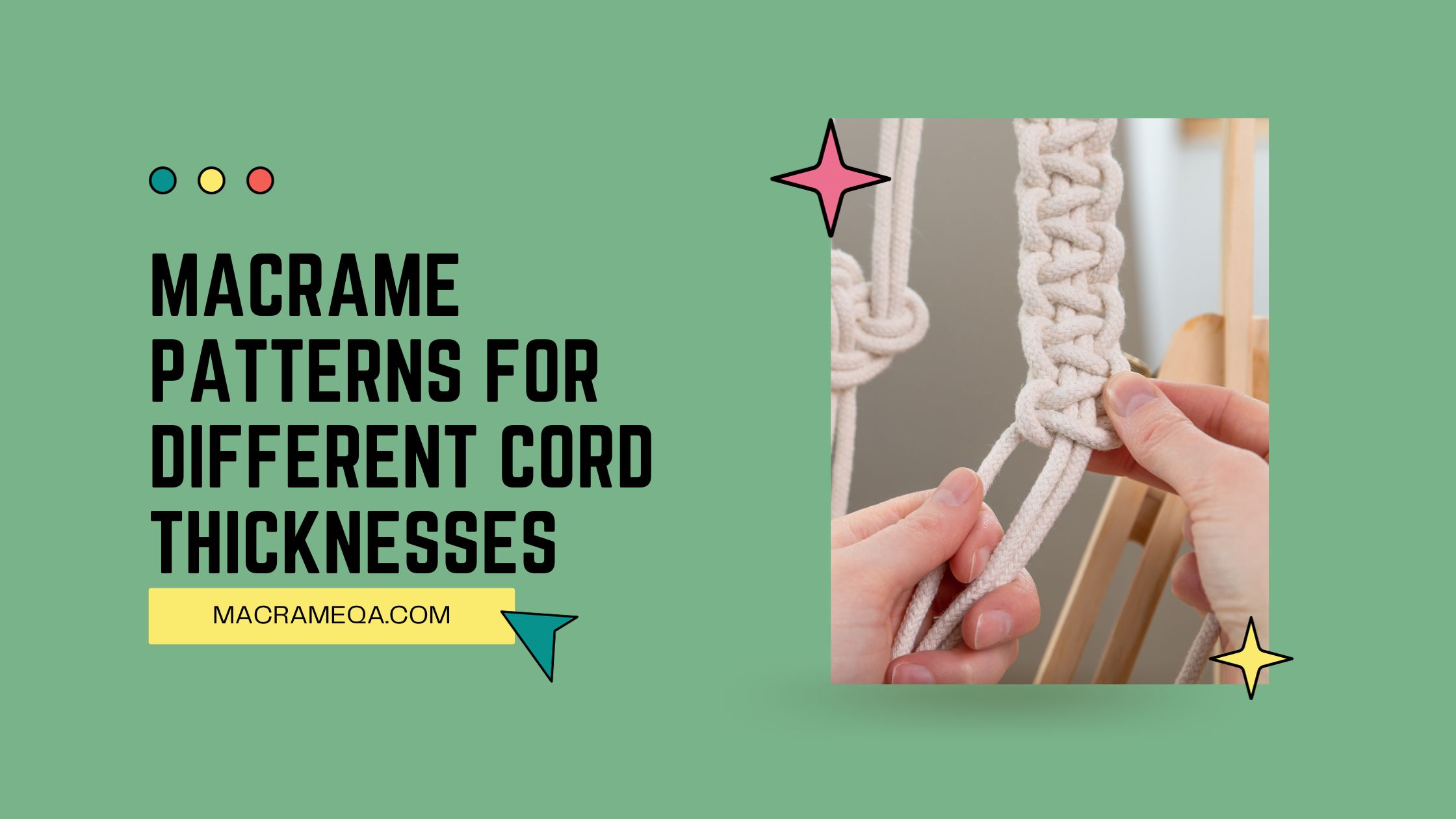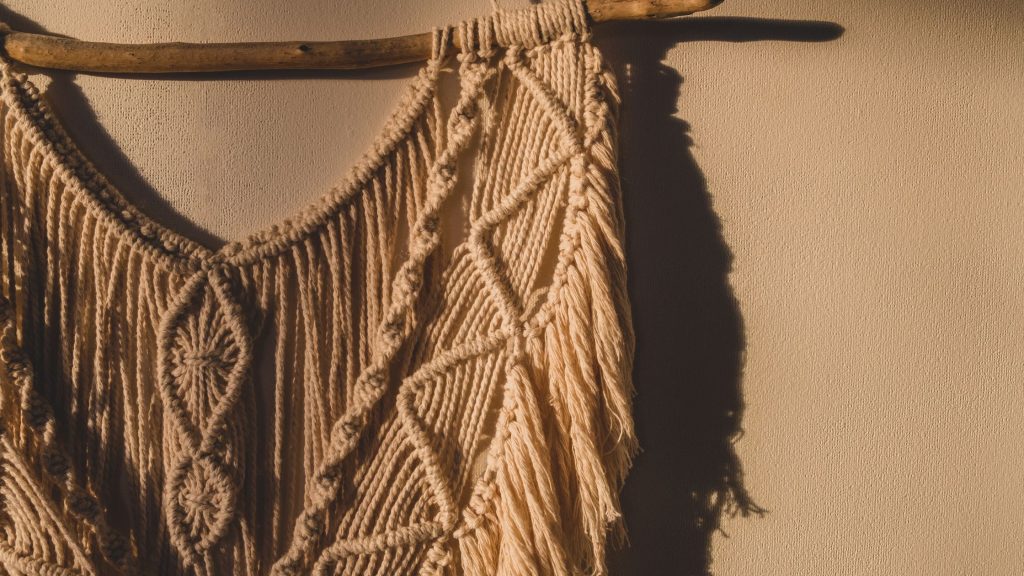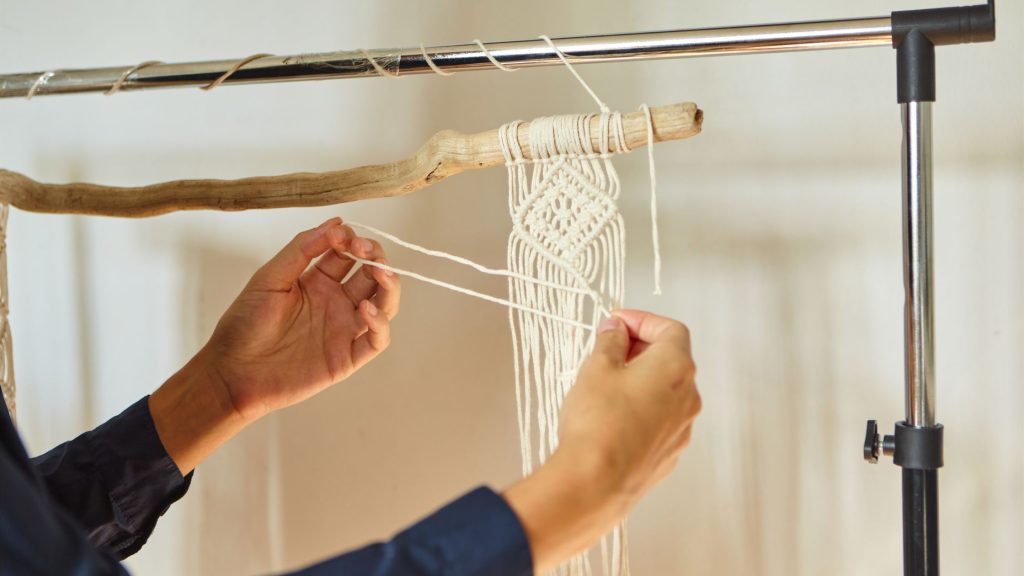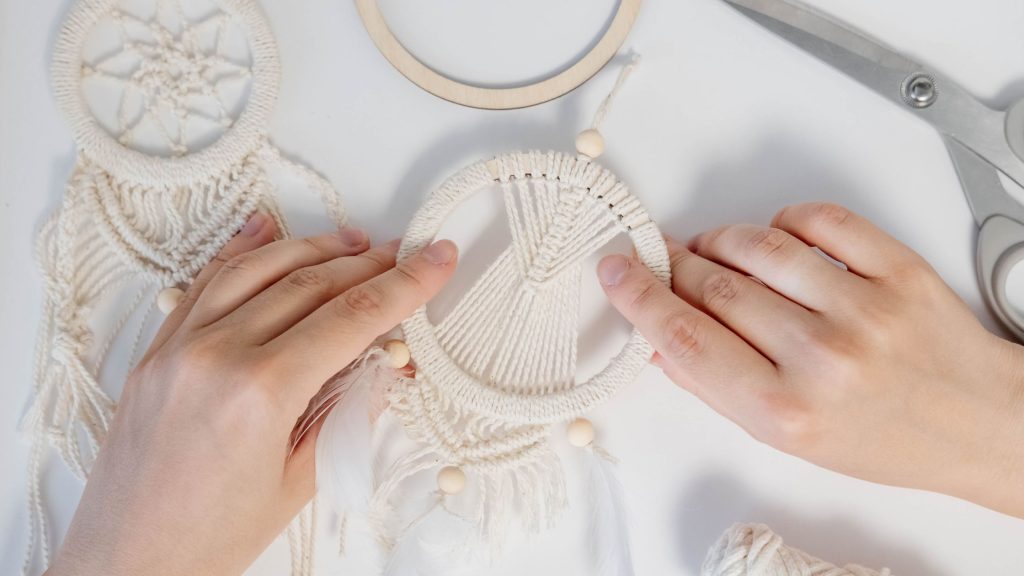Are you an avid macrame enthusiast looking to branch out and experiment with different cord thicknesses? If so, you may have wondered how to adjust macrame patterns to accommodate these variations. Thankfully, making this adjustment is easier than you might think. By understanding the basic principles of macrame and a few simple techniques, you’ll be able to adapt any pattern to suit your desired cord thickness. In this article, we will explore the various methods to help you adjust macrame patterns for different cord thicknesses, enabling you to unleash your creativity and bring your macrame projects to life.
Understanding Macrame Patterns
Macrame is a beautiful and versatile craft that involves creating intricate patterns and designs by knotting cords together. It has been practiced for centuries and has gained significant popularity in recent years. If you are new to macrame or looking to expand your skills, understanding macrame patterns is key. In this article, we will explore the importance of cord thickness in macrame and why you may need to adjust macrame patterns.
What is Macrame?
Macrame is an ancient craft that originated in the Middle East. It involves using various knots to create decorative textiles and intricate patterns. Traditionally, macrame was used to create items such as wall hangings, plant hangers, and jewelry. However, modern macrame has evolved to incorporate a wide range of projects, including clothing, accessories, and home decor.
In macrame, cords of different sizes and thicknesses are used to create different effects and textures. The thickness of the cord can greatly influence the overall design and appearance of a macrame piece. Therefore, understanding the importance of cord thickness is crucial when working with macrame patterns.
Importance of Cord Thickness in Macrame
The thickness of the cord you choose for your macrame project can have a significant impact on the final result. Thicker cords are generally more suitable for larger, chunkier designs, while thinner cords are better suited for delicate and intricate patterns. The thickness of the cord can affect the texture, structure, and overall visual appeal of the macrame piece.
Thicker cords create bolder and more substantial knots, resulting in a more prominent and pronounced design. They also provide greater stability and strength to the finished piece. On the other hand, thinner cords create finer and more intricate knots, allowing for more delicate and intricate patterns.
When selecting the cord thickness for your macrame project, it is essential to consider the desired outcome and the overall aesthetic you wish to achieve. Adapting macrame patterns to different cord thicknesses can help you achieve your vision and create unique and personalized pieces.
Why Adjust Macrame Patterns?
While macrame patterns often come with recommended cord sizes, there are instances where you may need to adjust the pattern to suit the cord thickness you have chosen. There are several reasons why you might find it necessary to adapt macrame patterns:
- Limited availability of specific cord thicknesses: Sometimes, you may not be able to find the exact cord thickness recommended in the pattern. Adapting the pattern allows you to work with the cords you have available.
- Personal preference: You may prefer the look and feel of a particular cord thickness and want to incorporate it into a pattern that calls for a different size. Adapting the pattern allows you to achieve your desired aesthetic.
- Customizing the design: Adapting macrame patterns gives you the freedom to customize the design to your liking. You can experiment with different cord thicknesses to create unique and one-of-a-kind pieces.
Now that we understand the importance of cord thickness in macrame and why adjusting macrame patterns may be necessary, let’s explore some considerations for adapting macrame patterns to different cord thicknesses.
Considerations for Adjusting Macrame Patterns
When adapting macrame patterns to different cord thicknesses, there are several factors to consider. These considerations will help ensure that the final result maintains the desired proportions, structural integrity, and aesthetic appeal. Let’s delve into these considerations:
Determining Cord Thickness
Before you can adapt a macrame pattern, you need to determine the thickness of the cord you wish to use. This can be done by referring to the manufacturer’s specifications or using a cord thickness gauge. Cord thickness is typically measured in millimeters or inches, with larger numbers indicating thicker cords and smaller numbers indicating thinner cords. Once you have determined the cord thickness, you can proceed with adjusting the macrame pattern accordingly.
Selecting the Right Macrame Pattern
Choosing the right macrame pattern is crucial when adapting it to different cord thicknesses. Some patterns may be more forgiving and allow for more flexibility in cord thickness, while others may require precise measurements to maintain symmetry and balance. Consider the complexity of the design, the number of cords involved, and the overall structure when selecting a macrame pattern to adapt.
Understanding the Impact of Cord Thickness
Each macrame knot and technique responds differently to different cord thicknesses. Thicker cords may require more space between knots to accommodate their bulk, while thinner cords may require tighter and more closely spaced knots to achieve the desired effect. Understanding the impact of cord thickness on the specific macrame pattern you are working with will help you make informed adjustments.
Now that we have explored the considerations for adjusting macrame patterns, let’s delve into the specific methods for adapting macrame patterns to different cord thicknesses.
Adapting Macrame Patterns for Different Cord Thicknesses
Adapting macrame patterns for different cord thicknesses involves making adjustments to various aspects of the pattern. Here are three primary methods for adapting macrame patterns:
Changing the Number of Cords
One of the most straightforward ways to adapt a macrame pattern to a different cord thickness is by changing the number of cords used. Adding or reducing the number of cords can help achieve the desired proportions and maintain the overall structure of the pattern.
When adding more cords, you can distribute them evenly across the pattern to maintain symmetry. Similarly, when reducing the number of cords, you may need to consider how to redistribute them to maintain the integrity of the design.
Modifying Knot Placement
Another method for adapting macrame patterns is by modifying the placement of knots. Spacing knots further apart or moving them closer together can help accommodate different cord thicknesses while maintaining the overall structure of the design.
Spacing knots further apart is suitable for thicker cords, as it allows the knots to breathe and prevents the final piece from appearing too crowded. Conversely, moving knots closer together is ideal for thinner cords, as it adds density and prevents the final piece from appearing sparse.
Altering the Design Structure
In addition to changing the number of cords and modifying knot placement, altering the design structure itself can help adapt a macrame pattern to different cord thicknesses. This involves adding supplementary knots, adjusting the length of knots, or incorporating additional elements into the design.
Adding supplementary knots can help bulk up thinner cords and provide a more substantial and textured look. Adjusting the length of knots can help accommodate thicker or thinner cords and ensure that the patterns align correctly. Incorporating additional elements, such as beads or charms, can also help enhance the design and mask any irregularities caused by adapting the pattern.
Now that we have explored the various methods for adapting macrame patterns let’s discuss some tools and techniques that can facilitate the adjustment process.
Tools and Techniques for Adjustment
When it comes to adjusting macrame patterns for different cord thicknesses, several tools and techniques can help streamline the process. These tools and techniques provide guidance and assistance in ensuring that the final result is consistent and visually appealing. Here are some tools and techniques to consider:
Macrame Cord Size Guide
A macrame cord size guide is an invaluable resource when working with different cord thicknesses. It provides recommendations and guidelines for which cord thicknesses work best with specific designs and patterns. Referencing a cord size guide can help you make informed decisions when adapting a macrame pattern and ensure consistent results.
Using Cord Calculators
Cord calculators are online tools that help determine the length of cord required for a specific macrame pattern. They take into account various factors, including cord thickness, knot type, and desired finished dimensions. Cord calculators can be particularly helpful when adapting a macrame pattern, as they ensure accurate measurements and minimize wastage.
Experimenting and Swatching
One of the best ways to gain confidence in adapting macrame patterns is through experimentation and swatching. Use scraps of cord, similar in thickness to what you plan to work with, and practice the various adaptations you will make to the pattern. This allows you to see how the changes affect the overall design and make any necessary adjustments before starting your actual project.
Now that we have discussed the tools and techniques for adjustment, let’s move on to testing and comparing the results of your adapted macrame pattern.
Testing and Comparing Results
It is crucial to test and compare the results of your adapted macrame pattern to ensure that it meets your expectations. Here are some steps you can take to test and compare the results:
Creating a Sample Macrame Project
Before embarking on a large-scale macrame project, it is advisable to create a sample or test piece using the adapted pattern. This allows you to identify any issues or inconsistencies and make further adjustments if necessary. The sample piece also serves as a reference for understanding the final outcome of the adapted pattern.
Documenting Adjustments
Keep a record of the adjustments you made to the original macrame pattern. This documentation includes details such as changes in cord thickness, knot placement modifications, or alterations in the design structure. This record will be valuable if you decide to recreate the adapted pattern in the future or share it with others.
Comparing Visual and Textual Guidelines
When testing and comparing the results of your adapted macrame pattern, it is helpful to refer to both visual and textual guidelines. Visual guidelines include comparing the sample piece to the original pattern and assessing any differences in symmetry, proportion, or overall aesthetic. Textual guidelines involve comparing the measurements and specifications of the adapted pattern to those of the original pattern. This ensures that the necessary adjustments have been made accurately.
Once you have tested and compared the results and are satisfied with the outcome, you can move on to troubleshooting and fine-tuning your adapted macrame pattern.
Troubleshooting and Fine-Tuning
Despite careful adjustments, you may encounter troubleshooting issues when adapting macrame patterns to different cord thicknesses. Here are some common troubleshooting steps and ways to fine-tune the pattern:
Identifying Tension Issues
Tension issues can arise when working with different cord thicknesses, resulting in an uneven or distorted macrame piece. If you notice differences in tension while working on your adapted pattern, try adjusting your knotting technique, or experiment with alternative tensioning methods. Practice and patience will help you refine your technique and achieve consistent tension throughout the project.
Refining Cord Thickness Ratio
If you find that the ratio of cord thicknesses in your adapted pattern is not visually appealing, you can refine it by making further adjustments to the number of cords, knot placement, or design structure. Experiment with different combinations until you achieve a visually balanced and aesthetically pleasing composition.
Seeking Community Support and Advice
If you encounter persistent issues or need guidance, do not hesitate to seek support from the macrame community. Online forums, social media groups, and local macrame workshops are excellent resources for troubleshooting and seeking advice. The macrame community is filled with experienced crafters who are often eager to share their knowledge and help fellow enthusiasts.
Now that we have explored troubleshooting and fine-tuning techniques let’s dive into maintaining consistency in macrame patterns.
Maintaining Consistency in Macrame Patterns
Maintaining consistency in macrame patterns is essential to ensure a cohesive and visually appealing design. Here are some practices to help maintain consistency:
Recording Adaptations
As mentioned earlier, keeping a record of the adaptations you make to macrame patterns is essential for consistency. By documenting the adjustments, you can easily recreate the adapted pattern in the future or share it with others. Consider creating a detailed tutorial or guide that outlines the modifications and provides step-by-step instructions.
Sharing Adjusted Patterns
If you have successfully adapted a macrame pattern to a different cord thickness, consider sharing your adjusted pattern with the macrame community. Sharing your knowledge and experiences helps foster creativity and innovation within the craft. You can share your pattern through online platforms, social media, or local macrame workshops.
Developing Personal Style
As you gain confidence and experience in adapting macrame patterns, you will develop your unique style and aesthetic. Embrace your creativity and experiment with different cord thicknesses, knot placements, and design structures. Developing your personal style adds a touch of individuality and uniqueness to your macrame pieces.
Conclusion
In conclusion, understanding macrame patterns and the importance of cord thickness is crucial for any macrame enthusiast. Adapting macrame patterns to different cord thicknesses allows for customization, creativity, and personalization of your projects. By considering cord thickness, selecting the right pattern, and understanding the impact of cord thickness, you can successfully adapt macrame patterns to suit your vision. Remember to utilize tools and techniques, test and compare results, troubleshoot and fine-tune, and maintain consistency to ensure beautiful and visually appealing macrame creations. Happy knotting!

















